-

人教版新目标初中英语七年级下册I ’d like some noodles教案
教学过程Step 1: warming-up Sing a song---------“food and drink” Step 2: Revision1 Dictation2 Revise: What kind of noodles would you like?I’d like …What size bowl of noodles would you like?I’d like…Step 3: Presentation1 show pictures of food, ask students say the words.2 Students read the newspaper ad in 3a. Fill in blanks with words in the box. Then read the ad together, the teacher explains some difficult language points.3 Check the answers Step 4 PracticeAsk students to finish 3b in the same way according to 3a. Students read the short passage and fill in the blanks .At last, check the answers.Step 5 productionAsk students to write their own ad for dumplings, noodles, drinks, and other foods they know. Then ask students to read their partner’s ad. Then order food and drink from their partner.Step 6 Home workGroup work – make an ad about “food and drink”

人教版新目标初中英语七年级下册I want to be an actor教案2篇
三、教学建议第一课时:1. Lead in (Vocabulary)A) Before class, teacher should collect some pictures of working places. For example: Bank, TV Station, Restaurant, Police Station, Hospital ...B) In class, show students the pictures (PowerPoint, OHP). Ask students to tell the name of the working places and the name of the jobs.Shop assistant, doctor, actor, reporter, police office, waiter, bank clerk, studentC) Do exercise 1a and 3a.2. Bingo GameAsk groups of students to make up pairs of cards with a job on one and the related workplace on the other. For example, waiter / restaurant, teacher / school, doctor / hospital. Encourage students to use both the job / workplace combinations in the book and the ones that students came up during class discussions. Be sure they have twice as many sets of cards as there are students in the group. They can make two sets of cards for a single job / workplace, if necessary. Then have each group mix up its set of cards and hand their cards out in random order. Each time a student gets a pair of cards that match, he or she can lay these cards down. The goal is to have no cards in your hand at the end.3. Task OneA) Ask students to work in pairs and ask the partner what does he / she want to be in the future.e. g. :What do you / does he / does she want to be?I want to be a.Why?Because it's (adj).B) Vocabulary: Section B, 1a4. Homework 1.2.

人教版新目标初中英语七年级下册Where is your pen pal from教案
2.1Match the country with the language.Step II Reading3a? let the students read the letter fast and answer the questions.? Let the students ask more questions about the letter as possible as the can.Step III Writing3b.Step IV. Pairwork2cStep V Listening2a, 2bStep V. HomeworkExercises book(1) P3Exercises book (2) P3Period FourStep I . Dictate the words and sentences in Unit1.Step II. Self-checkStep III. Check the answers for Exercises book in the unit.Step IV. Home workRevise and preparation for unit 2.教学反思:通过本单元的学习,学生基本可以谈论人们的国籍,居住城市及其所说的语言,通过书信方式去介绍自己并寻找笔友。但在涉及到国外的一些城市时,学生对这方面的知识相对欠缺,能介绍的城市并不多,也反应出学生课前预习不充分,这跟学生学习条件也有关,大多数学生无法通过网络获取所需信息。因此,在以后的教学中要多指导学生通过计算机网络获取信息,拓宽知识面。

人教版新目标初中英语七年级下册What do you think of game shows教案
五、教学Section B-2c1. Pair work: What do you think of the belt/sunglasses/…? What does your father/mother/… think of your scarf/belt…?2. Group work(1). Teacher shows some different kinds of school uniforms (制服)and asks : “ What do you think of your school uniforms? If you have a chance to choose your school uniforms, what kind would you like to choose?”(2). Discuss in groups.(3).Get some Ss to report in class.说明:这一步旨在让学生运用已有的语言知识谈论对事物的看法和意见,并简单阐明理由,培养学生的主动思维能力和运用英语的能力。六、教学拓展调查电视节目的收视率任务:调查你周围的人对现在各种电视节目的反响。活动过程:1.教师布置任务,让学生调查周围的人(包括他的亲戚朋友和邻居)喜欢收看哪方面的电视节目。2.学生进行调查活动,运用本单元所学的句型What do you think of….? (Why?)What's your favorite game shows?What do you think of talk show?I doesn’t mind it.I like it.I love it.I can’t stand it.3.记录下排在前10位的TV Program,填写调查表,比较其收视率。

人教版新目标初中英语七年级下册Where did you go on vacation教案
句型: Where did you go on vacation? I went to summer camp.Did she go to Central Park?Yes,she did.No, she didn’t语法:一般过去时特殊疑问句、一般疑问句及肯、否定回答。课时安排4课时第一课时:Section A:la,1b,lc,2a,2b,2c 第二课时:Section A:3a,3b,4第三课时:Section B:1,2a,2b,2c第四课时:Section B:3a,3b,3c,4 and Self Check第一课时教学目标掌握描写假期生活的形容词。假期里自己所做事情的简单表达。谈论假期做的事情及当时情况。谈论假期时旅游的天气,旅游者以及食物等。教学过程一、导入播放一首英文歌曲:Let’s travel 说明:通过让学生听节奏欢快迪斯尼英语歌曲Let’s travel.引入本节课谈论的话题vacation and travel. 让歌曲使学生的思维活跃,增强课堂气氛,激发学生提高学习英语的兴趣。T:How is the trip ?Ss : It’s pretty good/ happy/exciting /relaxing/busy/dangerous/ fantastic说明:这个问题是为了操练形容词。建议让多个Ss作答。鼓励他们用不同的形容词。上述个别形容词本应在第二课时中出现,但可以在warming-up中第一次非正式出现。这些形容词也可在老师的评价语中适时出现,以加深学生对词汇的印象。

人教版新目标初中英语八年级下册Have you ever been to an amusement park教案
(1)Have you ever been to …? Yes, I have. / Yes, I have ever been to …No, I haven’t. / No, I have never been to …(2)When did you go there? I went there last year. (3)I have never been to a water park. Neither have I. I have ever been to an amusement park. So have I. (4)How long have you been studying English? I’ve been studying English since nine o’clock. I’ve been studying English since I came back home. I’ve been studying English for five hours. (5)What’s that? It’s an amusement park in Japan. I’ve never been to an amusement park like it before. It’s fun to learn another language. Let’s go tonight. Isn’t this great?space museum, amusement park, water park, South America, Peru, Holland, European culture, tour guide, flight attendant, musical instrument, more than, be from, get to, take lessons, neither, discover, graduate, change

人教版新目标初中英语八年级下册It’s a nice day, isn’t it教案2篇
"Hello! Welcome to English class! Introduce yourself. Meet your new classmates." That's what the teacher says. What do you say? "Oh no!" It can be difficult talking to new people. But it can be fun, and you can make friends. How do you do it? Make small talk. Small talk is polite conversation. "Wang Nan is a great pingpang player, isn't she?" "I'd love to meet her, wouldn't you?" "It's been raining a lot, hasn't it?" Tag questions are a form of polite speech. To make small talk successfully, you should know how to make them. You should also know what topics to talk about. Try to learn this unit carefully. The next time you're in English class, you'll find out. Making small talk's easy, isn't it? (“你好!欢迎你!请做一下自我介绍。认识一下你的新同学。”通常在课上老师会这样说。你会说什么呢?“噢,不!”与陌生人谈话太困难了。但是这也很有意思,并且你还能交到朋友。你该怎么做呢?闲聊。闲聊指得是礼貌的对话。“王楠是一个很棒的乒乓球运动员,不是吗?”“我希望自己能认识她,你呢?“今年的雨水很多,不是吗?”反意疑问句是一种礼貌用语。为了使得谈话成功,你应该知道怎样去进行闲聊。你还应该知道与不同的人该谈论什么样的话题。认真的学习这个单元吧,下次在英语课上,你会发现与大家展开谈话是一件很容易的事情,不信我们来试试。)

人教版新目标初中英语八年级下册How long have you been collecting shells教案2篇
Step Ⅱ Show the new words on the screen and teach the new words. Read the new words to students and ask them to repeat.Step Ⅲ 3aThis activity introduces new vocabulary and provides reading practice using the target language.In this activity first look at the four pictures.T: What can you see in the pictures?Ss: Four snow globes.T: Right. There are four snow globes in the pictures. And what are they?Ss: They are a monster, two polar bears, two penguins and a birthday cake.Write these words on the blackboard: snow globe; monster; polar bear; penguin and birthday cake. Read them to the class and ask students to repeat each one. Make sure students understand each word.Use a computer to show the E-mail message on the screen and read the message to students.Get students to read the e-mail on their own, and then draw lines connecting each snow globe and its description.Correct the answers.AnswersA line should connect each snow globe picture with the words that describe it in the letter.Step Ⅳ 3bThis activity provides writing practice using the target language.First review Activity 2a on Page 47.Then ask students to complete the message according to Activity 2a.Some partial sentences are given to students. Write about one person's collection.When students work, walk around the room checking the progress and offering help as needed.When they finish, ask some students to read their messages to the class.

人教版新目标初中英语八年级下册What were you doing when the UFO arrived教案2篇
(一).知识方面: 1.培养学生能运用过去进行时来描述、谈论过去某个时间正在发生的事情或动作的意识和能力,能就过去某个时间正在发生的动作做出正确的描述。 2.培养学生的想象力和角色扮演的合作能力。 3.培养学生讲述过去发生的事情经过的能力。能正确运用一般过去时来讲述故事。 (二).技能方面: 1.本单元的语言目标是Talk about past events and tell a story(谈论过去的时间和讲述一个故事),围绕这一目标,要涉及句型: What were you doing when the UFO arrived? ----I was sitting in the barber’s chair. The barber was cutting my hair. 因此必须学习standing、studying、cleaning、sleeping、cooking、making、eating、cutting、等表示地点的词,以便为上述句型提供语言材料。2.学习过去进行时的有关知识。Was/were+现在分词,是该时态的表达式。 3.在学习过程中,要区分The boy was walking down the street when the UFO landed.和While the boy was walking down the street, the UFO landed.这两种由when和while引导的状语从句的句型结构。注意它们的不同。

人教版新课标小学数学四年级上册整万数的改写与省略说课教案
1、课本第14页的”做一做”。通过练习,一方面是让学生用刚学到的知识进行改写,进一步巩固了新知;一方面回忆过去提供的有关地理知识素材,使学生了解我国的地理知识,扩大视野。2、课本练习二的第3题。第3题的素材介绍了我国主要的农产品,可以扩大学生的知识面。在改写之后还要求学生进行大数的比较,对两部分知识进行混合练习。3、课文练习二的第4~5题。第4题是关于近似数的联系,通过准确数与近似数的对比,区分联系,题会在什么情况下使用准确数,在什么情况下使用近似数,使学生进一步理解近似数的含义和在实际生活中的作用。第5题是关于我国第五次人口普查中6个省份的人口数。让学生求出这些数的近似诉,并提示学生在可能的情况下通过互连网等媒体了解其他地区的人口数。同时还介绍了我国每十年进行一次人口普查的知识。
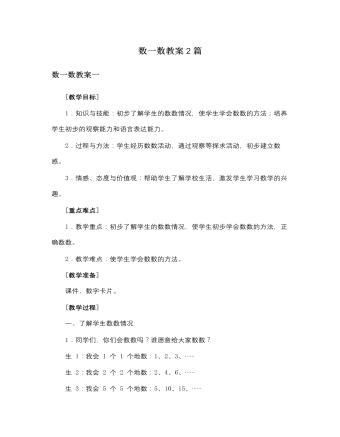
人教版新课标小学数学一年级上册数一数教案2篇
[在学生数的过程中再加强点数的指导,同时有意识的培养学生按顺序数数。另外,在数六朵花、八棵树、九名女生、十名男生的时候,除了 1 个 1 个地数以外,还可以引导学生 2 个 2 个地、3 个 3 个地、4 个 4 个地、5 个 5 个地数数,为后面学习 10 以内各数打基础。] (2)小组进行交流。 再从 1~10 数一数物体的个数。 (3)认一认。 师:你认识这些数吗?边指边读给大家听听。 生:边指 1~10 各数边读一读。 三、巩固练习 1.结合实物,开展数数活动。 (1)按要求数出下面物体的个数。 师:同学们刚才数得真不错!你们愿不愿意数一数自己文具盒中有几支铅笔呀? 生:数出自己文具盒中有几支铅笔并汇报。 师:请同学们数一数你的书包里共有几本书? 生:数出自己书包里共有几本书并汇报…… (2)自由数物体的个数。 师:你还想数哪些物体的个数?和同桌的小伙伴交流一下。
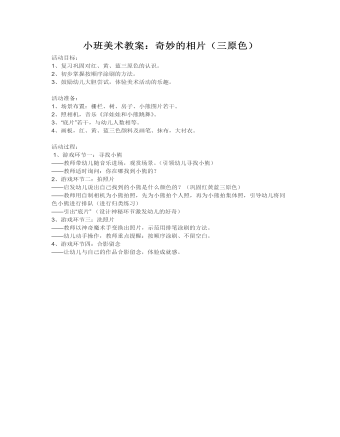
小班美术教案:奇妙的相片(三原色)
2、初步掌握按顺序涂刷的方法。 3、鼓励幼儿大胆尝试,体验美术活动的乐趣。 活动准备: 1、场景布置:栅栏、树、房子、小熊图片若干。 2、照相机,音乐《洋娃娃和小熊跳舞》。 3、“底片”若干,与幼儿人数相等。 4、画板,红、黄、蓝三色颜料及画笔、抹布,大衬衣。 活动过程: 1、游戏环节一:寻找小熊 ——教师带幼儿随音乐进场,观赏场景。(引领幼儿寻找小熊) ——教师适时询问:你在哪找到小熊的? 2、游戏环节二:拍照片
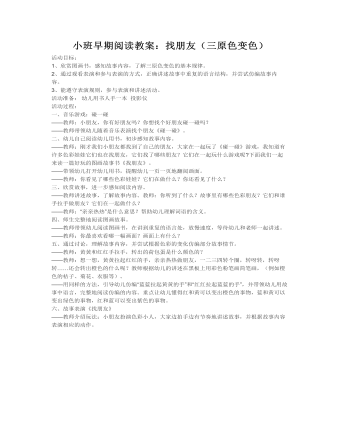
小班早期阅读教案:找朋友(三原色变色)
2、通过观看表演和参与表演的方式,正确讲述故事中重复的语言结构,并尝试仿编故事内容。 3、能遵守表演规则,参与表演和讲述活动。 活动准备: 幼儿用书人手一本 投影仪 活动过程: 一、音乐游戏:碰一碰 ——教师:小朋友,你有好朋友吗?你想找个好朋友碰一碰吗? ——教师带领幼儿随着音乐表演找个朋友《碰一碰》。 二、幼儿自己阅读幼儿用书,初步感知故事内容。 ——教师:刚才我们小朋友都找到了自己的朋友,大家在一起玩了《碰一碰》游戏,我知道有许多色彩娃娃它们也在找朋友,它们找了哪些朋友?它们在一起玩什么游戏呢?下面我们一起来读一篇好玩的图画故事书《找朋友》。 ——带领幼儿打开幼儿用书,提醒幼儿一页一页地翻阅画面。 ——教师:你看见了哪些色彩娃娃?它们在做什么?你还看见了什么?
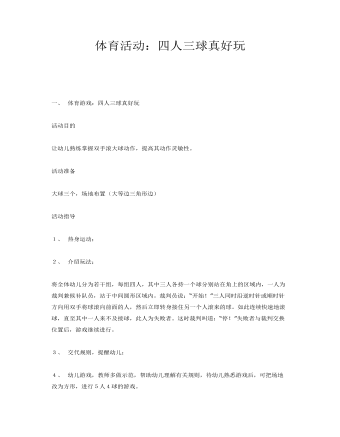
大班体育游戏:四人三球真好玩课件教案
让幼儿熟练掌握双手滚大球动作,提高其动作灵敏性。活动准备大球三个,场地布置(大等边三角形边)活动指导1、 热身运动;
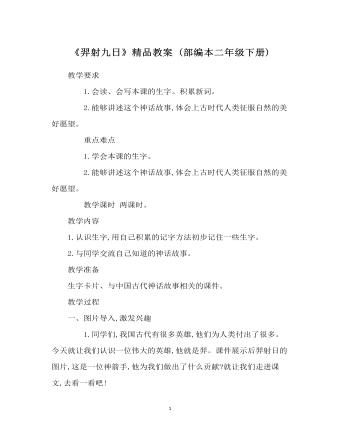
《羿射九日》教案
教学方法 1.自主、合作、探究的学习方法。在识记生字的时候,教师可以让同小组的同学做“找朋友”这个游戏,这样既提高了学生参与的兴趣,又能帮助他们很好地识记生字,一举两得。 2.初读课文,感知文本。让学生带着问题读课文,这样他们会一边读课文,一边思考。学习了生字后,教师可以要求学生用自由读、指名读、开火车读等方式,强化对生字的记忆。 能够讲述羿射九日的神话故事,体会上古时代人类征服自然的美好愿望。 教学过程 一、巩固生字 上节课,我们对羿射九日的故事有了大致的了解,并且分析了羿射日的原因,还学习了生字的认读,下面我们来检查一下我们的学习结果。 1.检查会认字、会写字读音。 (1)认读词(做“找朋友”的游戏) (2)开火车读,指名读。 2.指名学生回答羿射日的原因,经过和结果。 二、理解课文,朗读体会 1.默读课文,用自己的话大致向别人讲述一下《羿射九日》的故事。
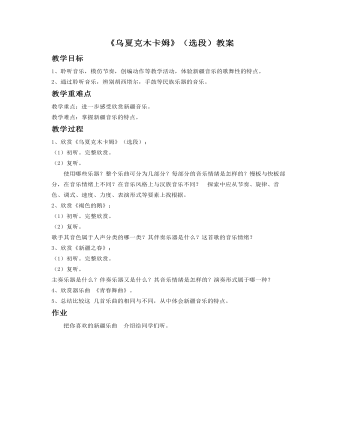
《乌夏克木卡姆》(选段)教案
1、欣赏《乌夏克木卡姆》(选段);(1)初听。完整欣赏。(2)复听。 使用哪些乐器?整个乐曲可分为几部分?每部分的音乐情绪是怎样的?慢板与快板部分,在音乐情绪上不同?在音乐风格上与汉族音乐不同? 探索中应从节奏、旋律、音色、调式、速度、力度、表演形式等要素上找根据。2、欣赏《褐色的鹅》;(1)初听。完整欣赏。(2)复听。歌手其音色属于人声分类的哪一类?其伴奏乐器是什么?这首歌的音乐情绪?3、欣赏《新疆之春》;(1)初听。完整欣赏。(2)复听。
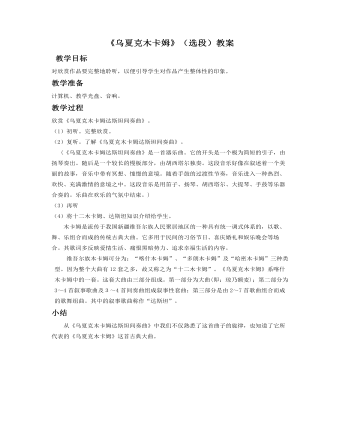
《乌夏克木卡姆》(选段)教案
木卡姆是流传于我国新疆维吾尔族人民聚居地区的一种具有统一调式体系的,以歌、舞、乐组合而成的传统古典大曲。它多用于民间的习俗节日、喜庆婚礼和娱乐晚会等场合。其歌词多反映爱情生活、痛恨黑暗势力、追求幸福生活的内容。 维吾尔族木卡姆可分为:“喀什木卡姆”、“多朗木卡姆”及“哈密木卡姆”三种类型。因为整个大曲有12套之多,故又称之为“十二木卡姆”。《乌夏克木卡姆》系喀什木卡姆中的一套。这套大曲由三部分组成。第一部分为大曲(即:琼乃额麦);第二部分为3~4首叙事歌曲及3~4首间奏曲组成叙事性套曲;第三部分是由2~7首歌曲组合而成的歌舞组曲。其中的叙事歌曲称作“达斯坦”。
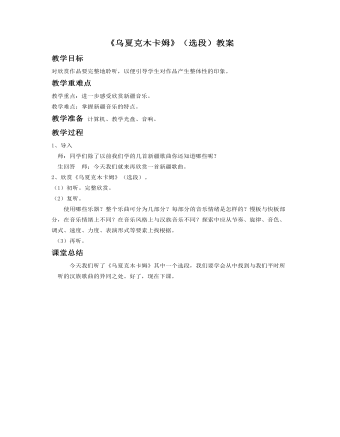
《乌夏克木卡姆》(选段)教案
教学重难点教学重点:进一步感受欣赏新疆音乐。教学难点:掌握新疆音乐的特点。教学准备 计算机、教学光盘、音响。教学过程1、导入 师:同学们除了以前我们学的几首新疆歌曲你还知道哪些呢? 生回答 师:今天我们就来再欣赏一首新疆歌曲。2、欣赏《乌夏克木卡姆》(选段)。(1)初听。完整欣赏。(2)复听。使用哪些乐器?整个乐曲可分为几部分?每部分的音乐情绪是怎样的?慢板与快板部分,在音乐情绪上不同?在音乐风格上与汉族音乐不同?探索中应从节奏、旋律、音色、调式、速度、力度、表演形式等要素上找根据。 (3)再听。 课堂总结 今天我们听了《乌夏克木卡姆》其中一个选段,我们要学会从中找到与我们平时所听的汉族歌曲的异同之处。好了,现在下课。

《鼓的语言》教案
展开。1.通过观看录像,了解非洲音乐与社会生活等方面的联系。要求:①仔细观察录像中所展现的内容,如:人们的服饰打扮、舞蹈动作,以及音乐与社会生活方面的联系等;②将所看到的内容记录在“音乐王国旅游护照”上。[培养仔细观察、整理信息的习惯和能力。] 2.出示课件:非洲音乐与社会生活方面的联系。[通过整理,加深印象。] 3.聆听鼓独奏《战士的舞蹈》,体会鼓的韵味,感受、探讨“鼓”在非洲音乐中所处的地位及其特点。[强化视听感受。] 用言简意赅的文字在“非洲音乐王国旅游护照”上记下对演奏乐器的印象和音乐风格特点的感受。听赏《战士的舞蹈》,共享组队(同桌二人组),探讨“鼓”在非洲音乐中所处的地位及其特点。分享、交换意见。[促进思维,加强合作探究。] 小结:鼓在非洲人民生活中的重要地位是任何其他乐器都无法比拟的,这是因为非洲音乐中最突出、最主要的因素是节奏,而鼓是非洲音乐节奏的基础,是表达音乐语言最重要的乐器之一。鼓不仅可以用于音乐,有时还是民族、部落或宗教和象征,甚至还可以传递各种信息。在非洲,不论是制造鼓的材料,还是鼓的形状,或是持鼓方式、演奏方式、演奏技巧等方面,都具有极其浓郁的民族特色。4.聆听西非现代歌舞曲《巴玛亚》(加纳),用言简意赅的文字在“非洲音乐王国旅游护照”上记下歌曲节奏和旋律的特点,以及演唱方式、伴奏和自我感受。[注重建立听觉印象。]
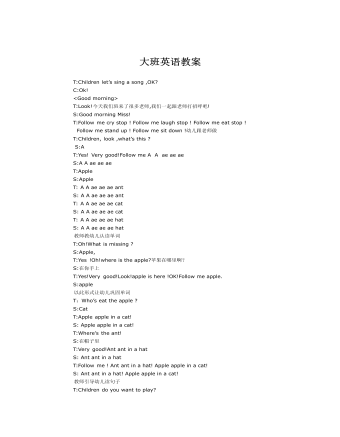
英语公开课教案
<Good morning> T:Look!今天我们班来了很多老师,我们一起跟老师打招呼吧! S:Goodmorning Miss! T:Follow mecry stop ! Follow me laugh stop ! Follow me eat stop ! Follow me stand up ! Follow me sit down !幼儿跟老师做 T:Children,look ,what’s this ? S:A T:Yes! Verygood!Follow me A A ae ae ae S:A A ae aeae T:Apple S:Apple T: A A ae aeae ant S: A A ae aeae ant T: A A ae aeae cat S: A A ae aeae cat T: A A ae aeae hat S: A A ae aeae hat